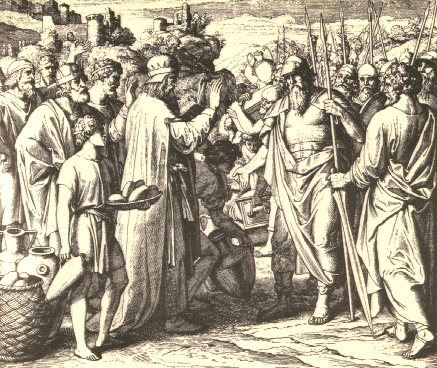The 19th book of the New Testament is usually called "The Epistle (or Letter) to the Hebrews." However, its form or genre is not really like an ancient letter (except for the ending), but more like a treatise and a homily (a sermon based on scripture). Moreover, this writing does not explicitly address any "Hebrews" (a title not attached until the second century), and its author was almost certainly not St. Paul (as had been assumed for much of Christian history). Nonetheless, the composition commonly known as "To the Hebrews" was one of the most influential early Christian writings, especially in showing how Christianity began understanding itself as separate from and superior to Judaism.
The structure of Hebrews is not easily discerned, and many different outlines have been proposed by various scholars. The main focus of this writing is on Christology, the proper understanding and interpretation of the identity and significance of Jesus Christ. Jesus is presented in several different ways: as the divine revelation/word of God, as the ultimate priest & sacrifice, and as the outstanding model and exemplar of faith in God.
| Jewish High Priests (and Their Sacrifices) |
Jesus as High Priest (and Perfect Sacrifice) |
| are called by God, chosen from among mortals, like Aaron was (5:1, 4) |
was appointed high priest by God, as God's own Son (4:14; 5:5; cf. already 2:17; 3:1) |
| can be compassionate with people, since they too are weak and sinful (5:2) |
can sympathize with human weakness, since he was tested as we are, but without sinning himself (4:15; 5:7) |
| offer sacrifices for their own sins as well as those of others (5:3; 7:27-28; 9:7, 9) |
offers sacrifices & prayers only for others, not for himself, since he is sinless & perfect (5:15; 7:26-28; 9:14) |
| are priests in the order of Aaron, from the tribe of Levi (5:4; 7:11) |
is a priest forever, "according to the order of Melchizedek" (5:6, 10; 6:20; 7:3, 17, 24; cf. Gen 14:17-20) |
| have an imperfect priesthood (levitical), inferior to Melchizedek's (7:1-11) |
is a priest of a new order (Melchizedek's) that replaces the levitical (7:11-19) |
| take office without an oath (7:20) |
has his priesthood confirmed with an oath from God (7:21; cf. Ps 110:4) |
| all eventually die, so there must be many priests and high priests (7:23) |
is the only permanent high priest, since he lives forever (7:16-17, 24-25) |
| offer sacrifices day after day, year after year (7:27; 9:6; 10:1, 11) |
offered himself as a sacrifice once for all time (7:27; 9:12, 14, 26; 10:10, 14) |
| hold office on earth, according to the law (8:4) |
has passed through the heavens, and is seated by God's throne ( 8:1; cf. 1:3; 4:14) |
| worship in an earthly sanctuary, a mere shadow of the heavenly one (8:5; 9:1) |
ministers in the heavenly tabernacle set up by God, not mortals (8:2, 9:11, 24) |
| follow the first covenant, the old covenant, given through Moses (8:7, 9) |
is the "mediator of a better covenant," a new covenant (8:6-13; 9:15-28) |
| enter the innermost "Holy of Holies" once a year (9:7) |
enters only once into the greater and perfect tabernacle (9:11-28; 10:10) |
| offer the blood of goats and calves (9:7, 13, 19, 25) |
offers his own blood, thus obtaining eternal redemption (9:12; 10:19) |
| their sacrifices are imperfect, since they use animals (9:23; 10:4) |
his sacrifice is perfect, since he himself is perfect/sinless (7:26, 28; 9:14) |
Most of this book seems like a theological treatise, with heavy use of biblical quotations and interpretations but with only a few scattered words of exhortation. In contrast, the last two chapters are filled with explicit exhortations directed at the Christian readers.
| Sunday of Ordinary Time |
Reading from Hebrews |
. |
Sunday or Feast; or Weekday in Ord.Time |
Reading from Hebrews |
| 27th Sunday of Ord.Time – Year B |
Heb 2:9-11 |
. |
4th Sunday of Advent – Year C |
Heb 10:5-10 |
| 28th Sunday of Ord.Time – Year B |
Heb 4:12-13 |
Christmas: Mass during the Day – Years ABC |
Heb 1:1-6 |
| 29th Sunday of Ord.Time – Year B |
Heb 4:14-16 |
Sunday within the Octave of Christmas:
Holy Family – Year B (opt.) |
Heb 11:8, 11-12, 17-19 |
| 30th Sunday of Ord.Time – Year B |
Heb 5:1-6 |
5th Sunday of Lent – Year B |
Heb 5:7-9 |
| 31st Sunday of Ord.Time – Year B |
Heb 7:23-28 |
Good Friday – Years ABC |
Heb 4:14-16; 5:7-9 |
| 32nd Sunday of Ord.Time – Year B |
Heb 9:24-28 |
Ascension of the Lord – Year C (opt.) |
Heb 9:24-28; 10:19-23 |
| 33rd Sunday of Ord.Time – Year B |
Heb 10:11-14, 18 |
Sunday after Trinity Sunday:
Body and Blood of Christ – Year B |
Heb 9:11-15 |
| 19th Sunday of Ord.Time – Year C |
Heb 11:1-2, 8-19 or 11:1-2, 8-12 |
Week 1 of Ord. Time – Mon to Sat – Year I |
Heb 1, 2, 3, 4 (selections) |
| 20th Sunday of Ord.Time – Year C |
Heb 12:1-4 |
Week 2 of Ord. Time – Mon to Sat – Year I |
Heb 5, 6, 7, 8, 9 (selections) |
| 21st Sunday of Ord.Time – Year C |
Heb 12:5-7, 11-13 |
Week 3 of Ord. Time – Mon to Sat – Year I |
Heb 9, 10, 11 (selections) |
| 22nd Sunday of Ord.Time – Year C |
Heb 12:18-19, 22-24a |
Week 4 of Ord. Time – Mon to Sat – Year I |
Heb 11, 12, 13 (selections) |

